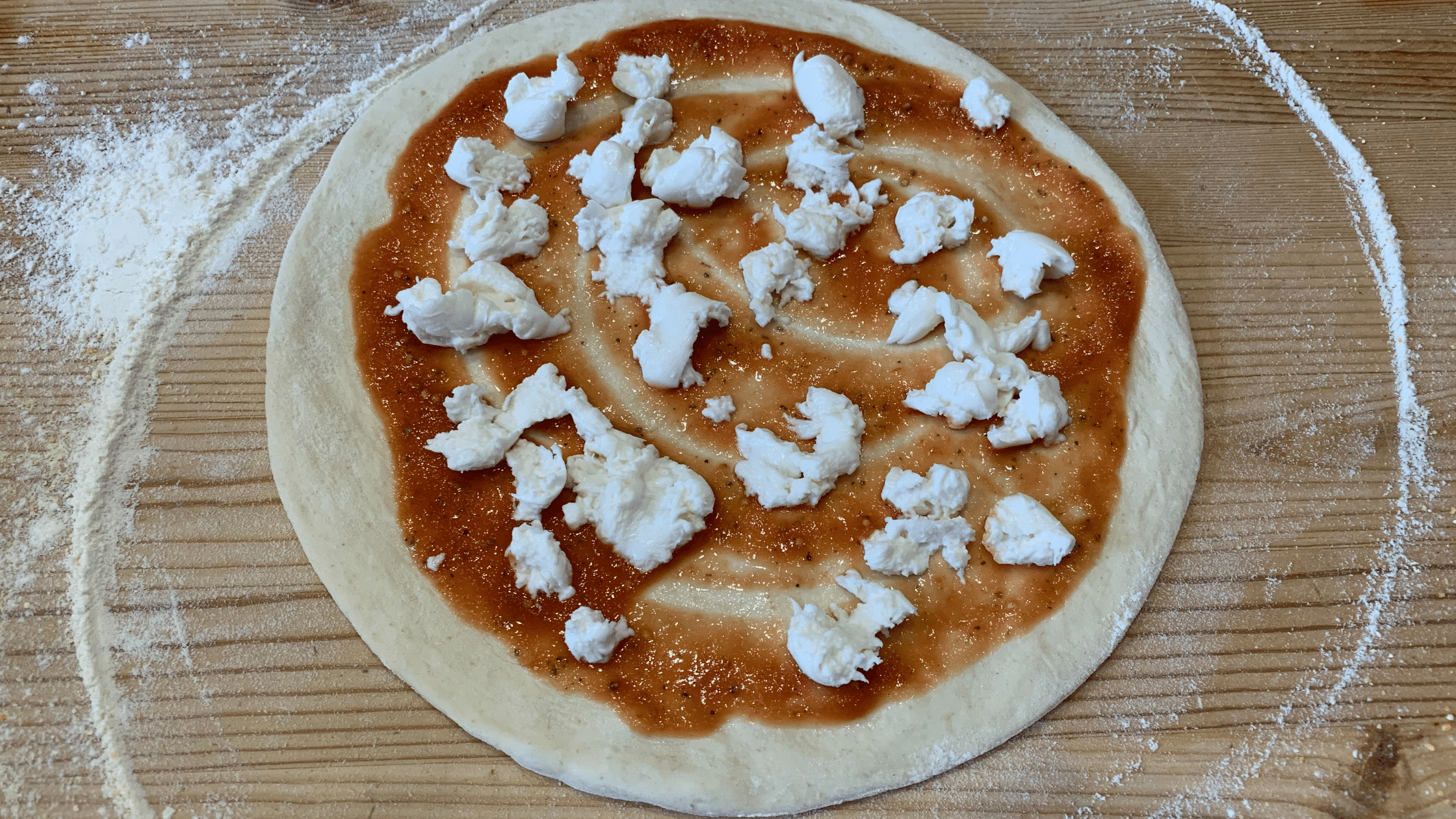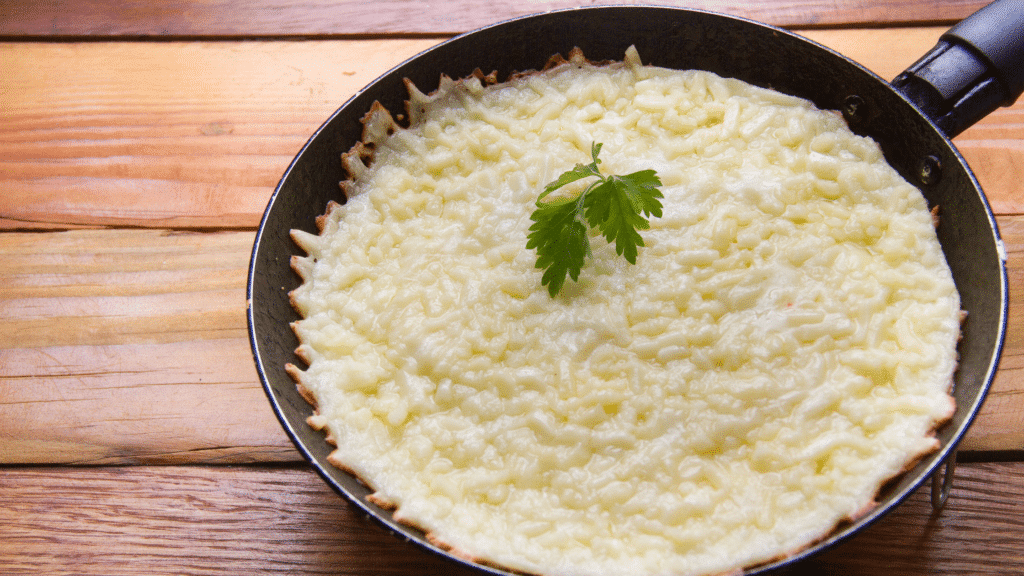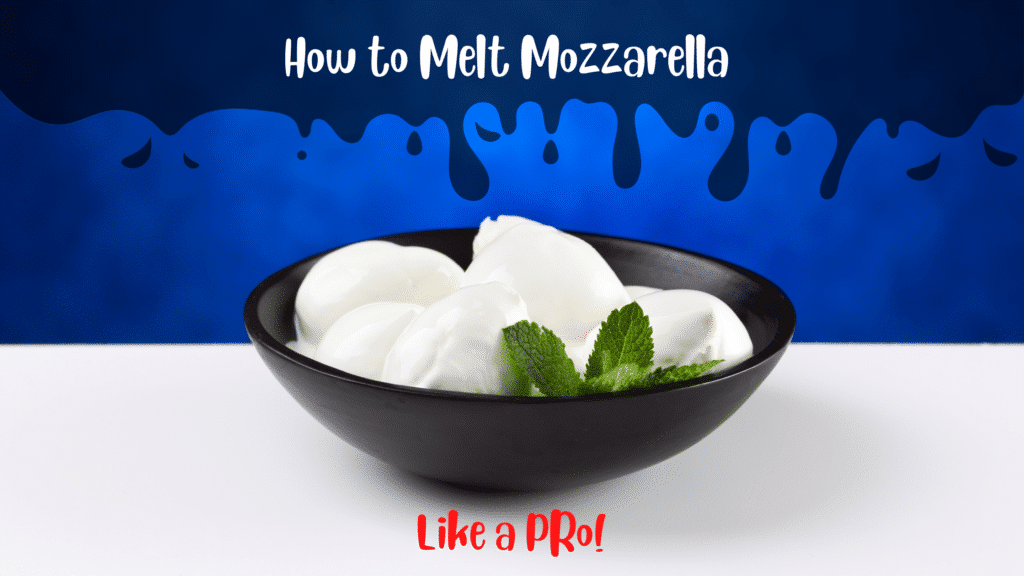Are you ready to embark on an epic journey to transform your homemade pizza game with the ultimate secret to heavenly, melted mozzarella cheese?
Imagine biting into a slice of pizza crowned with a blanket of ooey-gooey, perfectly melted mozzarella that stretches into long, irresistible strings with each pull. No more clumpy or unevenly melted cheese, just pure pizza paradise!
Unlock the full potential of your favorite pizza recipes as you become a PRO in the art of melting mozzarella specifically tailored for pizza. Keep reading to uncover expert techniques and insider tips that will have your friends and family begging for your secret.
So grab your apron and make your pizza night a mozzarella masterpiece!
Here’s What You Will Find:
Key Takeaways
How to Melt Mozzarella Cheese
The best mozzarella cheese for melting is processed mozzarella (low moisture mozzarella, whole-milk mozzarella, and shredded mozzarella).
Fresh mozzarella cheese can melt but may melt differently than processed mozzarella cheese.
You can melt mozzarella cheese in the microwave, on the stove, or in a regular oven.
The melting point of mozzarella cheese is at temperatures above 130 degrees F or 55 degrees C.
How to Melt Mozzarella Cheese
To melt mozzarella cheese effectively, choose the appropriate type of mozzarella, with low-moisture or pre-shredded varieties being the most suitable for melting. Grate the mozzarella into uniform shreds if not already shredded, ensuring consistent melting.
Next, prepare a double boiler by filling a saucepan with an inch or two of water and placing a heatproof bowl on top, ensuring the bowl does not touch the water. Heat the water in the saucepan over medium heat until it reaches a gentle simmer.
Place the shredded mozzarella cheese into the heatproof bowl, stirring gently and frequently with a silicone spatula to encourage even melting. As the cheese melts, reduce the heat to low to prevent overheating or scorching. If desired, add a small amount of milk or cream to the melting cheese to create a smoother, more pourable consistency.
Continue stirring until the mozzarella is fully melted and achieves a smooth, velvety texture, then immediately remove the bowl from the heat to prevent overcooking or clumping. Use the melted mozzarella cheese in your desired recipe or as a topping for various dishes, such as pizza, pasta, or vegetables.
Tips on Melting Mozzarella Cheese
We may, at times, have difficulties when melting mozzarella cheese. Sometimes, the equipment used may be wrong, the technique may be complex, or we have no clue what is right and wrong.
When a recipe calls for melted mozzarella, it is not as easy as throwing in a block of cheese and expecting it to melt easily.
Cheeses are a combination of curds, fat, water, and oil, and when you melt cheese, you will most likely get a separation of these elements as they liquefy at different temperatures.
Below are tips to help you melt mozzarella cheese quickly:
- Begin with Smaller Cheese Pieces
Melting big chunks of mozzarella cheese is not wise since you may get uneven results. Try grating, shredding, or slicing your cheese to give more surface area to receive heat.
Dicing cheese is easy and can be done using a serrated knife, a box grater (coarse side), or an essential kitchen knife. You can also purchase pre-shredded mozzarella or sliced mozzarella cheese in grocery stores.
- Ensure Your Cheese is at Room Temperature Before Melting
Planning a pizza baking session is essential as it reminds you to remove your cheese from the fridge for thawing before melting. When you melt your cheese immediately, you take it off the fridge.
It gives your pizza an overly greasy taste and appearance, which may be awful to pizza lovers. Thus the importance of thawing to room temperature.
- Use Evaporated Milk or Its Substitutes
Pizza recipes, at times, require the use of evaporated milk to stop the cheese from separating. Some people skip the step since they cut off dairy products, which harms the pizza outcome.
Substitute this with non-dairy milk like almond milk or other nut milk. Since you only require a splash of milk, it will not affect the mozzarella flavor.
Plant-based milk is often too watery. Take extra time to evaporate it. Milk and cream are other substitutes for evaporated milk.
- Use Only Nonstick Pans
Using nonstick pans when melting cheese is essential since it becomes very sticky.
Use rubber or silicone spatulas when scrapping the sticky cheese, for they are made of nonstick material; thus, do not destroy your kitchenware.
Nonstick equipment is easy to clean and maintain too.
Does Mozzarella Cheese Melt?
Yes, mozzarella cheese melts at temperatures above 130 degrees F or 55 degrees C since it contains high moisture content.
At 90 degrees F, it begins to soften but usually does not form a gooey cheese sauce like some cheese forms.
The solid milk fat in mozzarella liquefies upon heating, thus breaking the casein proteins, which are the significant cheese components.
The age of mozzarella cheese is crucial in determining how your cheese will melt.
Fresh mozzarella has casein protein molecules that are still significant and stretchy since they are not aged.
It takes only a few minutes for it to liquefy.
However, it does not melt as well as its aged counterpart since it contains high moisture content.
Does Fresh Mozzarella Cheese Melt?
Fresh mozzarella cheese can melt but may melt differently than processed mozzarella cheese.
Fresh mozzarella is a cheese made from cow’s milk with a soft, creamy texture and a mild, slightly tangy flavor. It is often used in dishes such as Caprese salad and pizzas, which can be sliced or torn into pieces and added to the dish.
When fresh mozzarella is heated, it can become soft and slightly gooey, but it may not completely melt or become as smooth and creamy as processed mozzarella cheese.
This is because fresh mozzarella contains more moisture than processed mozzarella, making it more difficult to melt.
However, with the proper techniques and patience, it is possible to melt fresh mozzarella cheese to create a creamy, gooey texture.
Fresh mozzarella is melted in a microwave in its shredded, diced, or sliced form at a 50 percent power level. Stir the fresh cheese till it melts to the required consistency.
Fresh mozzarella is the best option for your Italian pasta. Once placed on the plate, the soft cheese turns gooey in no time and is not highly melted.
When melting the fresh mozzarella in a pan, use a nonstick option. Spread the cheese evenly on the hot pan for even melting.
If desired, add cornstarch or evaporated milk to a smooth texture.
Fresh mozzarella melts in sauces.
However, it does not give a smooth, creamy sauce result as achieved by aged cheddar or high-moisture cream cheeses.
You better leave the mozzarella for pizza. Drain and dry your cheese for 15 to 20 minutes to prepare fresh mozzarella for pizza. Shred, dice, or tear it into manageable pieces before evenly spreading it on the pizza.

Use a sharp serrated cheese knife or a thin-bladed option to cut fresh mozzarella for pizza. Use the whole blade to slice through the fresh mozzarella ball.
Lasagna is not perfect without fresh mozzarella. Its creamy, buttery nature melts beautifully on the lasagna and mixes well with the tomato sauce incorporated in the dish.
If you prefer less watery lasagna, opt for shredded mozzarella instead of the new option. Grate your fresh mozzarella on a coarse box grater for efficiency.

Best Types of Mozzarella Cheese for Melting
There is more to mozzarella than the commonly found shredded part-skim cheese. Mozzarella is categorized into fresh and low-moisture cheese, which is aged and dried.
Low moisture mozzarella cheese melts better than any other and is commonly used for pizza making.
Here is a guide to help you pick the best melty mozzarella cheese for your pizza making and how to melt the mozzarella.
- Processed Mozzarella
Processed or commercially made mozzarella melts better than fresh because it has lesser water density. This allows your pizza to have gooey cheese strings. It is easy to grate and adds texture to your meal.
- Whole Milk Mozzarella
The cheese melts quicker than part skim mozzarella cheese and browns better too. It has a softer texture due to its high-fat content and gives off a better flavor if it is slightly aged.
Because of its gooey nature, it has a better holding ability on your pizza than most mozzarella cheeses.
- Shredded Mozzarella
The cheese has low moisture content and is often sold in a bag. It is one of the best choices for making American and New York-style pizzas since it melts quickly and adds a mild tangy flavor.
It browns excellently with bubbly formations.
When purchasing mozzarella, or for a block, shred it by hand at home.
There are significant advantages to this as opposed to purchasing pre-shredded mozzarella.
Factory shredded mozzarella cheese has preservatives such as natamycin and potato starch.
They are meant to stop the shredded cheese from clumping in the bag. When used for pizza making, it will not melt as smoothly as one shredded by hand.
Freshly shredded mozzarella will taste better due to the extra creamy taste not being destroyed by preservatives.
- String Cheese
This is your product when looking for extra stretches, like the one you see in pizza commercials. When purchasing, ensure the packaging reads mozzarella string cheese, not cheddar or any other.
It is perfect for making string cheese pizza rolls.
String cheese may be difficult to melt in a microwave. It melts wholly at a temperature above 32 degrees C; for even melting, slice your string cheese thinly for even melting when used as a pizza topping.
Avoid melting the cheese in a microwave with its package since some are not microwave friendly.
- Buffalo Mozzarella
Buffalo mozzarella is popularly famed for its creamy consistency and smooth texture. It has twice as much fat as basic mozzarella cheese and is used to make authentic Neapolitan pizzas.
To melt low moisture buffalo mozzarella in a microwave, place it in a safe bowl and heat it to 50 % heat level. Stir till you get the right consistency. Eating in a preheated oven takes about 7 to 8 minutes.
It is an excellent choice for pizza toppings for its rich tangy and sweet flavor compared to regular mozzarella.
- Stracciatella
It means ‘rags’ in Italian since it combines mozzarella shreds and cream.
It has a soft gooey consistency that is ideal for finishing your pizza.
However, spread this on your pizza after taking it out of the oven. Stracciatella is more watery due to the cream incorporation.
Thus, it becomes watery if combined with pizza in an oven. Ensure it is the last ingredient to avoid soggy pizzas.
- Vegan Mozzarella
Lactose-intolerant persons have a mozzarella option manufactured to melt quite well.
Vegan cheese form bubbles and stretch like real mozzarella under temperatures above 130 degrees F, as required for regular mozzarella. It becomes soft and stringy.

What is the Best Way to Melt Mozzarella Cheese?
The microwave is the most convenient technique to melt mozzarella cheese. You may also melt it in the oven using the broiler setting or in a double boiler on the stovetop.
The secret is to choose a mellow mozzarella kind, such as a high-fat version.
How to Melt Mozzarella Cheese (3 Ways)
How to Melt Mozzarella Cheese in the Microwave
Using a microwave is the fastest way to have your melted mozzarella. Watch the timer and keep stirring to the required consistency.
Here are steps on how to set the cheese in the microwave oven:
- Place the sliced/shredded mozzarella in a microwave safe bowl or container.
- Incorporate a little evaporated milk and a pinch of cornstarch to stop the cheese from separating upon melting; if you have no evaporated milk, substitute with almond, coconut, soy, or hemp milk.
- Add a bit of acidic ingredients, such as distilled white vinegar or lemon juice, to ensure the cheese remains smooth upon melting. Do not use components with heavy flavors like beer or wine.
- Place the mozzarella in the microwave. Set the timer to 30 seconds high setting.
- Remove the bowl and stir to a smooth, gooey mixture.
- Where lumps form in the mixture, return to the microwave for a few seconds till complete melting occurs.
Please avoid over-stirring the cheese, as it may become lumpy instead of smooth.
How to Melt Mozzarella Cheese in the Oven
It is possible to melt mozzarella in the oven using the broiler setting. This setting provides direct and concentrated heat to your cheese, thus breaking down the fats.
Mix your mozzarella with spices and herbs to make it flavorful for an added flavor. A cast-iron skillet is necessary for the process.
Here are steps to follow when placing your cheese in the oven:
- Use the low heat setting of the broiler oven as you begin.
- Place slices of mozzarella on the cast iron skillet.
- Spread some olive oil or oil of choice on the cheese.
- Position the pan under the broiler and leave it to sit for about 5 to 8 minutes.
- Please take out the cheese and spread it on your pizza.
How to Melt Mozzarella Cheese on the Stove
Melting mozzarella on a stove requires a double boiler or a saucepan filled with water and a bowl that fits perfectly on the pan.
Here are the steps to follow for the melting process:
- Shred your cheese and position it on the broiler’s top pan. If following a recipe, measure your mozzarella first to avoid wastage.
- Maintain the heat between low and medium.
- The water heating action at the bottom produces steam which melts the cheese. Be patient, as it is quite a slow process.
- Use a silicone spatula to scrape off the melted cheese on the pot’s side and mix it with what has not melted. Avoid leaving the melted cheese on the side, as it will burn.
- Stir to accelerate melting.
- Add evaporated milk, the mentioned substitutes, and cornstarch to eliminate cheese separation when total melting starts.
- Stir to a complete melt.

The most significant advantage of using a stovetop is the allowance to keep your cheese warm till ready. When using a saucepan, ensure it is made of nonstick material.
Keep the heat low and use shredded or grated mozzarella cheese for even melting. to keep the cheese smooth, add vinegar, cornstarch, and milk of choice for a smooth consistency.
You can also add a small slice of American cheese for additional creaminess.
Reasons Why Your Mozzarella Cheese is Not Melting
Is your mozzarella cheese giving you trouble during melting?
You are probably using the wrong type of mozzarella.
Here are reasons to look out for and see what is affecting your progress and how to melt mozzarella properly.
- Moisture Content
Mozzarella cheese generally has a high moisture content, especially in its new state.
This stops it from melting as the water absorbs some heat to release steam. Opt for aged low moisture mozzarella or processed options; this type of mozzarella is less watery.
- Cheese Age
Mozzarella does not have to be aged. When aged, it should not be let to stay for long. Avoid using fresh mozzarella or high moisture mozzarella on your pizza, as its high moisture content gives a soggy texture. Regular mozzarella is slightly aged and thus quickly melts. Keep that in mind when purchasing mozzarella for pizza.
- Fat Content
How much fat is in your mozzarella cheese? Low or no-fat mozzarella cheese does not melt well during pizza baking. It browns and gets excessively scorched, giving it an undesirable taste and texture. Purchase mozzarella that has high fat, such as whole milk mozzarella.
The Last Slice
We hope you are now a PRO! on melted mozzarella cheese.
Mozzarella cheese is easy to use and gives us the authentic taste of Italian pizza. Fresh and regular mozzarella alike is necessary for different pizza outcomes and preferences.
The tips and guides on melting mozzarella shown above will make you an excellent pizza maker and attract others to your baking area.
Additional Cheese Resources
Enjoy!
Not a PRO? Not a Problem!
Take a pizza class to bring your pizza skills to the next level,
so you can be a PRO!
Related Posts

Costco Pizza Delivery: Find How You Can Get It Now!
the PROs
People go to Costco’s food court for many different reasons, but the cheesy slice of pizza they serve is among …

Pizza for Beginners: Don’t Buy Pizza, Make It! Here’s How to Get Started!
the PROs
You have this idea that you want to make pizza at home as opposed to ordering it, but where do you start? Don’t worry! Here you will find answers and directions to all your questions.

Pizza Toppings Under Cheese or Over Cheese? [Why the Order Matters]
the PROs
Is Pizza Cheese on Top or Bottom? Hey pizza lovers, are you wondering if you should layer pizza toppings under …
Newsletter
Subscribe to our Recipe of the Week newsletter and receive our partners’ latest recipes, tips, and discount offers.
Keep in Touch!

